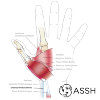LiveLife
Member
1. Practice with 1/4 sheet and 1/2 sheet of copy paper as your targets. Set them at 5 yards to start and practice until you can get all your shots as fast as you can shoot then move them out to 7-10-15 yards.Any other thoughts?
After you practice with smaller 1/4 and 1/2 sheet targets, the shoot area of your no-shoot targets will be bigger than what you practiced with and you will be more confident in shooting at your normal "fast" speed (Remember what Rob Leatham said? "Why would you ever shoot any slower?"). Actually, you can even "gray" them out during the stage and just see the 1/4 and 1/2 sheet targets superimposed on the shoot part of the target.
Finally, range practice by making your own shoot/no shoot targets by duplicating the different match setups and practice at different distances. Practice until you shoot no-shoot targets just as fast as regular targets.
2. Viewing "right side" video, looks like you were "palming" the magazine with a hesitation (to verify mag well?). Orient the magazine in the mag pouch so bullet nose faces front. Practice grabbing the magazine with left index finder in front of the magazine/follower to index with mag well while shooting hand is raising/tilting the pistol to aid in mag insertion into the mag well (while quickly visualizing/glancing top of magazine entering mag well). Practice mag change so mag drop to getting pistol back on target is done in one smooth motion without hesitation.
3. What are you talking about? Even Rob Leatham has a belly. I have a belly (well, not as big as yours, maybe like Rob's). Belly doesn't keep you from isolating the trigger finger to release the hammer/striker without moving the front sight. Consistently "jerking" the trigger without moving the pistol is what Rob wants us to do to shoot fast and accurate. He never said we had to have skinny bellies to shoot fast and accurate. I have taught point shooting to many people with all sorts of bellies and they all went "tap tap" without any issues. Now, moving quickly from targets to targets, that's a different story.



 And yeah...I just got the holster I was working with (heck, just got the pistol too). I'll spend some time getting the holster position worked out, I'll fully admit I hadn't spent any time there.
And yeah...I just got the holster I was working with (heck, just got the pistol too). I'll spend some time getting the holster position worked out, I'll fully admit I hadn't spent any time there.





